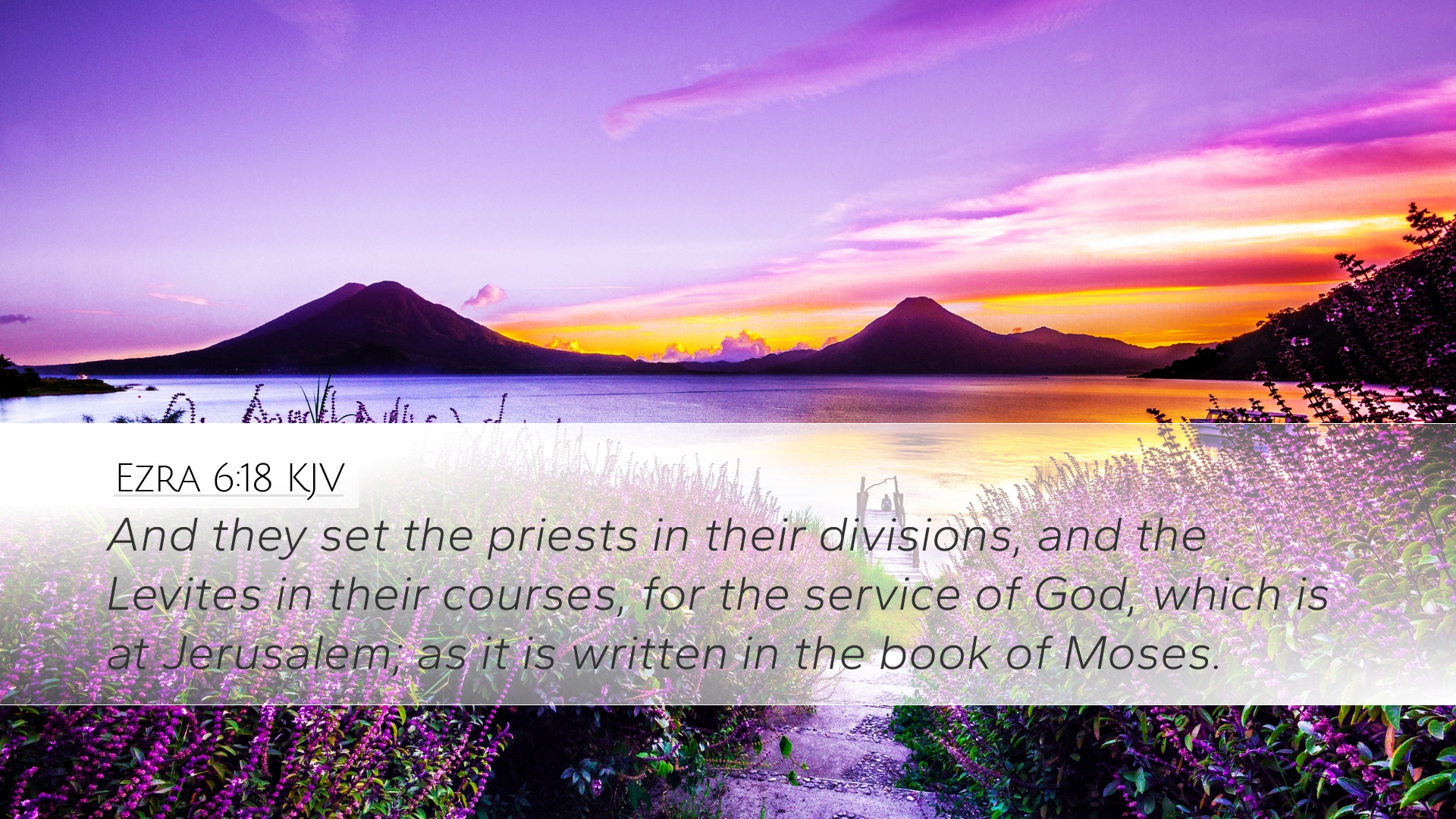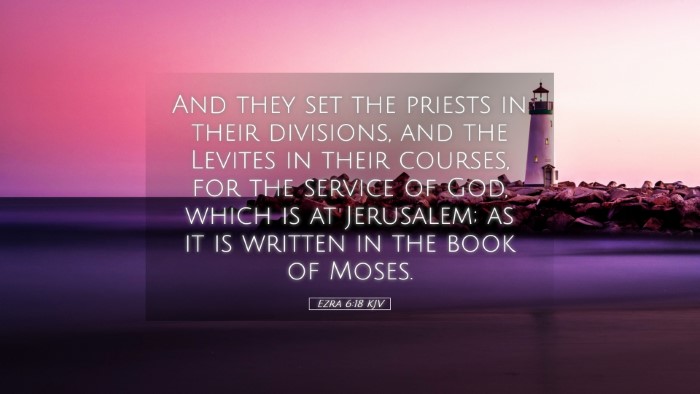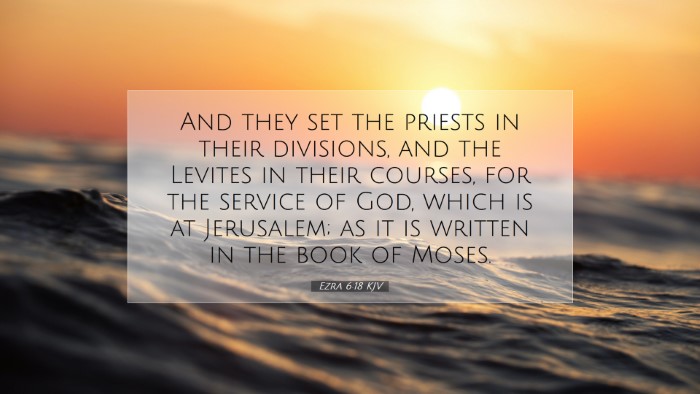Old Testament
Genesis Exodus Leviticus Numbers Deuteronomy Joshua Judges Ruth 1 Samuel 2 Samuel 1 Kings 2 Kings 1 Chronicles 2 Chronicles Ezra Nehemiah Esther Job Psalms Proverbs Ecclesiastes Song of Solomon Isaiah Jeremiah Lamentations Ezekiel Daniel Hosea Joel Amos Obadiah Jonah Micah Nahum Habakkuk Zephaniah Haggai Zechariah MalachiEzra 6:18
Ezra 6:18 KJV
And they set the priests in their divisions, and the Levites in their courses, for the service of God, which is at Jerusalem; as it is written in the book of Moses.
Ezra 6:18 Bible Commentary
Commentary on Ezra 6:18
Ezra 6:18 states:
"And they set the priests in their divisions, and the Levites in their courses, for the service of God, which is at Jerusalem; as it is written in the book of Moses."
Introduction
This verse marks a significant moment in the restoration of the post-exilic community in Jerusalem. It reflects the temple's dedication and the establishment of organized religious practice according to the Mosaic Law. The importance of proper ordering of worship, the roles of the priests and Levites, and adherence to divine specifications are foundational themes in this passage.
Insights from Matthew Henry
Matthew Henry emphasizes the meticulous setting of the organization of priests and Levites as a crucial step in restoring worship in Jerusalem. He points out:
- Divine Order: The arrangement of the priests and Levites was not arbitrary but was founded on divine instruction, showcasing how God desires order in the worship of His people.
- Importance of the Law: Henry highlights that the reference to the "book of Moses" signifies the importance of Scripture in guiding worship practices. This adherence to the sacred text was foundational for the community’s identity and their relationship with God.
- Role of the Levites: He notes that the Levites, set apart for the service of God, were instrumental in ministering and assisting the priests in their duties, thus reinforcing the communal aspect of worship.
Insights from Albert Barnes
Albert Barnes provides an interpretative perspective that underscores the significance of the restored priesthood:
- Restoration of Worship: Barnes argues that the action taken in this verse indicates the full restoration of the temple worship after the Babylonian captivity, which reflects God’s faithfulness to His covenant people.
- Scriptural Fulfillment: He insists that the fulfillment of the directives in the "book of Moses" not only points to obedience but also symbolizes the continuity of God’s covenant with Israel.
- Functionality of the Community: The detailed division into courses and divisions shows the organized structure necessary for effective worship, which serves as a model for church governance and order in contemporary times.
Insights from Adam Clarke
Adam Clarke’s commentary illuminates the theological underpinnings of this organizational structure:
- Spiritual Leadership: Clarke stresses that the priests and Levites function as spiritual leaders, emphasizing the importance of their roles in teaching and guiding the community in righteousness.
- Significance of Unity: He reflects on how these divisions not just serve logistical purposes but foster a spirit of unity and discipline among the worshippers, important for collective worship practices.
- Historical Context: Clarke contextualizes this verse within the larger historical narrative, noting that Israel's previous neglect of such organization had led to their downfall, portraying the institution of this order as both redemptive and preventive against future disobedience.
Theological Implications
The implications of Ezra 6:18 transcend the immediate historical context and pose significant questions for today’s faith community:
- Authority of Scripture: The emphasis on the "book of Moses" reminds us today of the authority of Scripture in guiding worship and life, underscoring the necessity of returning to biblical principles in all aspects of church practice.
- Worship as Community: The collective organization of worship leaders reveals that worship is primarily a community act rather than an individual one. This is crucial for understanding the communal aspects of faith in modern congregational life.
- Role of Leadership: The prescribed roles of the priests and Levites inform contemporary discussions on church leadership, suggesting that clear roles and organization are vital for spiritual health and effective ministry.
Practical Application
For pastors, students, and scholars, this verse calls for practical reflection:
- Evaluating Church Structure: Consider how your church structures its leadership and worship, ensuring alignment with biblical models of governance and practice.
- Reinforcing Teaching: Encourage the teaching of the Scriptures in your communities; equip leaders and laypersons alike with the knowledge and application of God’s Word.
- Fostering Unity: Strive to cultivate unity and collaboration among church members, reflecting the communal nature of worship established in Ezra’s time.
Conclusion
Ezra 6:18 provides a profound insight into the restoration of worship in ancient Israel that resonates with theological and practical significance today. The careful organization of priestly duties serves as a reminder of God’s desire for order and fidelity to His Word, inviting us to reflect on our practices of worship, community, and leadership.


